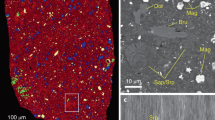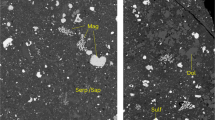Abstract
C-type asteroids are the source of the carbonaceous chondrite meteorites and represent remnants of primitive planetesimals that formed at the outer margins of the early Solar System and may have delivered volatiles to the inner Solar System, in particular the early Earth. However, the nature of carbonaceous chondrites is not well understood owing to terrestrial alteration. Here, we present the petrology and mineral chemistry of surface materials collected by the Japan Aerospace Exploration Agency (JAXA) Hayabusa2 spacecraft from the C-type asteroid Ryugu. The Ryugu particles we studied are similar to CI (Ivuna-type) chondrites but with some important differences, such as the presence of Na–Mg phosphates and Na-rich phases and the lack of ferrihydrite and gypsum. Ryugu particles experienced several steps of aqueous alteration, metasomatism and brecciation under variable conditions. These materials represent mixed lithologies and formed at different locations within their parent asteroid. The evidence presented here demonstrates that the C-type asteroid Ryugu experienced a complex geologic evolution shortly after its formation.
This is a preview of subscription content, access via your institution
Access options
Access Nature and 54 other Nature Portfolio journals
Get Nature+, our best-value online-access subscription
$29.99 / 30 days
cancel any time
Subscribe to this journal
Receive 12 digital issues and online access to articles
$119.00 per year
only $9.92 per issue
Buy this article
- Purchase on Springer Link
- Instant access to full article PDF
Prices may be subject to local taxes which are calculated during checkout





Similar content being viewed by others
Data availability
Correspondence and requests for materials should be addressed to A.Y. All analytical data related to this manuscript will be put on the JAXA Data ARchives and Transmission System (DARTS) after a 1-year proprietary period. Source data are provided with this paper.
References
Yada, T. et al. Preliminary analysis of the Hyabusa2 samples returned from C-type asteroid Ryugu. Nat. Astron. 6, 214–220 (2021).
Kitazato, K. et al. Surface composition of asteroid 162173 Ryugu as observed by the Hayabusa2 NIRS3 instrument. Science 364, 272–275 (2019).
Ikeda, Y. An overview of the research consortium, Antarctic carbonaceous chondrites with CI affinities, Yamato-86720, Yamato-82162, and Belgica-7904. Proc. NIPR Symp. Antarct. Meteor. 5, 49–73 (1992).
King, A. J. et al. The Yamato-type (CY) carbonaceous chondrite group: analogues for the surface of asteroid Ryugu. Geochemistry 79, 125531 (2019).
Ito, M. et al. A unique and pristine record of outer Solar System materials from C-type asteroid Ryugu. Nat. Astron. https://doi.org/10.1038/s41550-022-01745-5 (2022).
Yokoyama, T. et al. Samples returned from the asteroid Ryugu are similar to Ivuna-type carbonaceous meteorites. Science https://doi.org/10.1126/science.abn7 (2022).
Nakamura, E. et al. On the origin and evolution of the asteroid Ryugu: a comprehensive geochemical perspective. Proc. Jpn. Acad. Ser. B 98, 227–282 (2022).
Greenwood, R. C. et al. Oxygen isotope analysis of Ryugu particles: fresh evidence for hydration of Earth by CI chondrites. Nat. Astron 7, 29–38 (2022). 2022.
Morlok, A. et al. Brecciation and chemical heterogeneity of CI chondrites. Geochim. Cosmochim. Acta 70, 5371–5394 (2006).
Alfing, J., Patzek, M. & Bischoff, A. Modal abundances of coarse-grained (>5 μm) components within CI- chondrites and their individual clasts – mixing of various lithologies on the CI parent body(ies). Geochemistry 79, 125532 (2019).
Tomeoka, K. & Buseck, P. R. Matrix mineralogy of the Orgueil CI carbonaceous chondrite. Geochim. Cosmochim. Acta 52, 1627–1640 (1988).
Marty, B. et al. Origins of volatile elements (H, C, N, noble gases) on Earth and Mars in light of recent results from the ROSETTA cometary mission. Earth Planet. Sci. Lett. 441, 91–102 (2016).
Walsh, K., Morbidelli, A., O’Brien, D. P. & Mandell, A. M. Populating the asteroid belt from two parent source regions due to the migration of giant planets – ‘The Grand Tack’. Meteor. Planet. Sci. 47, 1941–1947 (2012).
Anders, E. & Grevesse, N. Abundances of the elements: meteoritic and solar. Geochim. Cosmochim. Acta 53, 197–214 (1989).
Barrat, J. A. et al. Geochemistry of CI chondrites: major and trace elements, and Cu and Zn Isotopes. Geochim. Cosmochim. Acta 83, 72–92 (2012).
Liu, M.-C. et al. Incorporation of 16O-rich anhydrous silicates in the protolith of highly hydrated asteroid Ryugu. Nat. Astron. 6, 1172–1177 (2022).
Tomioka, N. et al. Calibrating the shock regime experienced by hydrated asteroid Ryugu. Nat. Astron. (in press).
McCain, K. A. et al. Early fluid activity on the Ryugu asteroid: perspectives from oxygen, carbon, and 53Mn-53Cr isotope systems. Nat. Astron. https://doi.org/10.1038/s41550-022-01863-0 (2023).
Zolotov, M. Y. Aqueous fluid composition in CI chondritic materials: chemical equilibrium assessments in closed systems. Icarus 220, 713–729 (2012).
Kerridge, J. F., McKay, A. L. & Boynton, W. V. Magnetite in CI carbonaceous meteorites: origin by aqueous activity on a planetesimal surface. Science 205, 395–397 (1979).
Tatsumi, E. et al. Collisional history of Ryugu’s parent body from bright surface boulders. Nat. Astron. https://doi.org/10.1038/s41550-020-1179-z (2021).
Komatsu, M. et al. LIME silicates in amoeboid olivine aggregates in carbonaceous chondrites: indicator of nebular and asteroidal processes. Meteorit. Planet. Sci. 50, 1271–1294 (2015).
Paul, R. L. & Lipshutz, M. E. Consortium study of labile trace elements in some Antarctic carbonaceous chondrites: Antarctic and non-Antarctic meteorite comparisons. Proc. NIPR Symp. Antarct. Meteor. 3, 80–95 (1990).
Weisberg, M. K., McCoy, T. J. & Krot, A. N. in Meteorites and the Early Solar System II (eds Lauretta, D. S. & McSween, H. Y.) 19–52 (Univ. of Arizona Press, 2006).
Rubin, A. E., Trigo-Rodriguez, J. M., Huber, H. & Wasson, J. T. Progressive aqueous alteration of CM carbonaceous chondrite. Geochimica. Cosmochimica. Acta 71, 2361–2382 (2007).
Kimura, M. et al. The most primitive CM chondrites, Asuka 12085, 12169, and 12236, of subtypes 3.0–2.8: their characteristic features and classification. Polar Sci. 26, 100565 (2020).
Noguchi, T. et al. Mineralogy of fine-grained matrix, fine-grained rim, chondrule rim, and altered mesostasis of a chondrule in Asuka 12169, one of the least altered CM chondrites. Polar Sci. 29, 100727 (2022).
Rubin, A. E. & Li, Y. Formation and destruction of magnetite in CO3 chondrites and other chondrite groups. Geochemistry 79, 125528 (2019).
Bullock, E. S., Gounelle, M., Lauretta, D. S., Grady, M. M. & Russell, S. S. Mineralogy and texture of Fe-Ni sulfides in CI1 chondrites: clues to the extent of aqueous alteration on the CI1 parent body. Geochim. Cosmochim. Acta 69, 2687–2700 (2005).
Podolak, M. & Zucker, S. A note on the snow line in protostellar accretion disk. Meteor. Planet. Sci. 39, 1859–1868 (2010).
Akai, J. T-T-T diagram of serpentine and saponite, and estimation of metamorphic heating degree of Antarctic carbonaceous chondrites. Proc. NIPR Symp. Antarct. Meteor. 5, 120–135 (1992).
Berger, E. L. et al. Heterogeneous histories of Ni-bearing pyrrhotite and pentlandite grains in the CI chondrites Orgueil and Alais. Meteorit. Planet. Sci. 51, 1813–1829 (2016).
Berger, E. L., Keller, L. P. & Lauretta, D. S. An experimental study of the formation of cubanite (CuFe2S3) in primitive meteorites. Meteorit. Planet. Sci. 51, 1813–1829 (2015).
Brearley, A. J. in Meteorites and the Early Solar System II (eds Lauretta, D. S. & McSween, H. Y.) 587–624 (Univ. of Arizona Press, 2006).
Wasson, J. T. Meteorites: Classification and Properties (Springer-Verlag, 1974).
McSween, H. Y. et al. Carbonaceous chondrites as analogs for the composition and alteration of Ceres. Meteor. Planet. Sci. 53, 1793–1804 (2018).
Ito, M. et al. The universal sample holders of microanalytical instruments of FIB, TEM, NanoSIMS, and STXM-NEXAFS for the coordinated analysis of extraterrestrial materials. Earth, Planets Space 72, 133 (2020).
Uesugi, M. et al. Development of a sample holder for synchrotron radiation-based computed tomography and diffraction analysis of extraterrestrial materials. Rev. Sci. Instrum. 91, 035107 (2020).
Jochum, K. et al. Determination of reference values for NIST SRM 610-617 glasses following ISO guidelines. Geostand. Geoanal. Res. 35, 397–429 (2011).
Yang, S. et al. Siderophile and chalcophile element abundances in shergottites: implications for Martian core formation. Meteorit. Planet. Sci. 50, 691–714 (2015).
Walker, R. J. et al. Modeling fractional crystallization of group IVB iron meteorites. Geochim. Cosmochim. Acta 72, 2198–2216 (2008).
Bland, P. A., Gressey, G. & Menzies, O. N. Modal mineralogy of carbonaceous chondrites by X-ray diffraction and Mössbauer spectroscopy. Meteor. Planet. Sci. 39, 3–16 (2004).
Endreβ, M. & Bischoff, A. Carbonate in CI chondrites: clues to parent body evolution. Geochimica. Cosmochimica. Acta 60, 489–507 (1996).
Acknowledgements
We thank all the scientists and engineers of the Hayabusa2 project whose dedication and skill brought these precious particles back to Earth. This research was supported in part by the JSPS KAKENHI (grant nos. JP19H01959 to A.Y., JP20H01965 to N.T., JP18K18795 and JP18H04468 to M.I., JP18K03729 to M.K., JP18H05479 (Innovative Areas ‘MFS Materials Science’) to M.U., JP21K03652 to N.I., JP17H06459 to T.Okada, JP17H06459 to T.U., JP18K03830 to T.Y., JP19K03958 to M.A., and JP17H06459 and JP19H01951 to S.W.), and by the NIPR Research Project (grant no. KP307 to A.Y.).
Author information
Authors and Affiliations
Contributions
A.Y. led the project and wrote the initial draft. A.Y., N.T., M.K., N.I. K.A.M, M.-C.L., N.M., R.G.C. and M.I. performed optical and scanning electron microscopy–energy-dispersive spectroscopy and EPMA analysis. FIB-TEM work was done by N.T. A.Y. and N.S. performed LA–ICP–MS analysis. M.U. performed SXRD analysis at SPring-8. A.Y., N.T., M.I., M.U., T.Ohigashi., N.I., N.S., A.N., H.Y.,Y.Kodama and K.Y. conducted sample handling, preparation and mounting processes of Ryugu grains. M.I., N.T., M.U., T.Ohigashi., K.U., K.H., Y.Karouji, I.S. and I.O. developed universal sample holders for several instruments. A.N., K.Y., A.M., M.N., T.Y., T.Okada., M.A. and T.U lead the JAXA curation activities for initial characterization of allocated Ryugu particles. S.N., T.Okada., T.S., S.T., F.T., M.Y., S.W. and Y.T. administered the project and acted as principal investigators. All authors contributed to the data interpretation and commented on and finalized the paper.
Corresponding author
Ethics declarations
Competing interests
The authors declare no competing interests.
Peer review
Peer review information
Nature Astronomy thanks Cyrena Goodrich and Munir Humayun for their contribution to the peer review of this work.
Additional information
Publisher’s note Springer Nature remains neutral with regard to jurisdictional claims in published maps and institutional affiliations.
Supplementary information
Supplementary Information
Supplementary Figs. 1–12 and Tables 1–6.
Source data
Source Data Fig. 3
Si+Al, Na+K and Mg+Fe (mol%) for the Ryugu particles we studied and Y 980115 and Orgueil.
Source Data Fig. 4
Source data for the X-ray diffraction pattern (angles and X-ray intensity).
Rights and permissions
Springer Nature or its licensor (e.g. a society or other partner) holds exclusive rights to this article under a publishing agreement with the author(s) or other rightsholder(s); author self-archiving of the accepted manuscript version of this article is solely governed by the terms of such publishing agreement and applicable law.
About this article
Cite this article
Yamaguchi, A., Tomioka, N., Ito, M. et al. Insight into multi-step geological evolution of C-type asteroids from Ryugu particles. Nat Astron 7, 398–405 (2023). https://doi.org/10.1038/s41550-023-01925-x
Received:
Accepted:
Published:
Issue Date:
DOI: https://doi.org/10.1038/s41550-023-01925-x
This article is cited by
-
A history of mild shocks experienced by the regolith particles on hydrated asteroid Ryugu
Nature Astronomy (2023)



